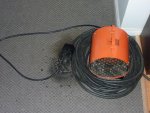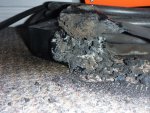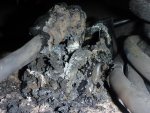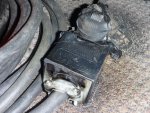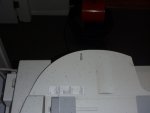Rampage_Rick
Senior Member
- Location
- British Columbia, Canada
I've got an office-type building that's been vacant for the past 6 months. I guess they'd been using one of those 4800W construction heaters late last year. The heater is connected to about 50 feet of cabtire of appropriate size. Today it was discovered that there had been a fire of some sort at the plug/receptacle. The event was caught indirectly on a security camera about a week ago.
My observations:
- The heater is fairly new, standard 4800W 240V with factory 6-30P connector. The switch was in the "off" position.
- The receptacle is a standard rectangular Leviton 6-30R with a standard metal clamp in a 1" KO.
- About 50 feet of 6/3 cabtire run into the panel. (Hot+Hot+Ground) Cable had been coiled up for storage, but was still energized.
- A 30A 2-pole QBH-type bolt-on breaker (I believe it's C.E.B brand, possibly C-H, not Sylvania) The breaker had not tripped when I looked at it.
I can't figure out why it failed after such an extended period of time... The only possible answer I can come up with is perhaps some critter crawled inside the 6-30R and shorted the hots? The biggest hole is maybe 1/4"...
My observations:
- The heater is fairly new, standard 4800W 240V with factory 6-30P connector. The switch was in the "off" position.
- The receptacle is a standard rectangular Leviton 6-30R with a standard metal clamp in a 1" KO.
- About 50 feet of 6/3 cabtire run into the panel. (Hot+Hot+Ground) Cable had been coiled up for storage, but was still energized.
- A 30A 2-pole QBH-type bolt-on breaker (I believe it's C.E.B brand, possibly C-H, not Sylvania) The breaker had not tripped when I looked at it.
I can't figure out why it failed after such an extended period of time... The only possible answer I can come up with is perhaps some critter crawled inside the 6-30R and shorted the hots? The biggest hole is maybe 1/4"...

